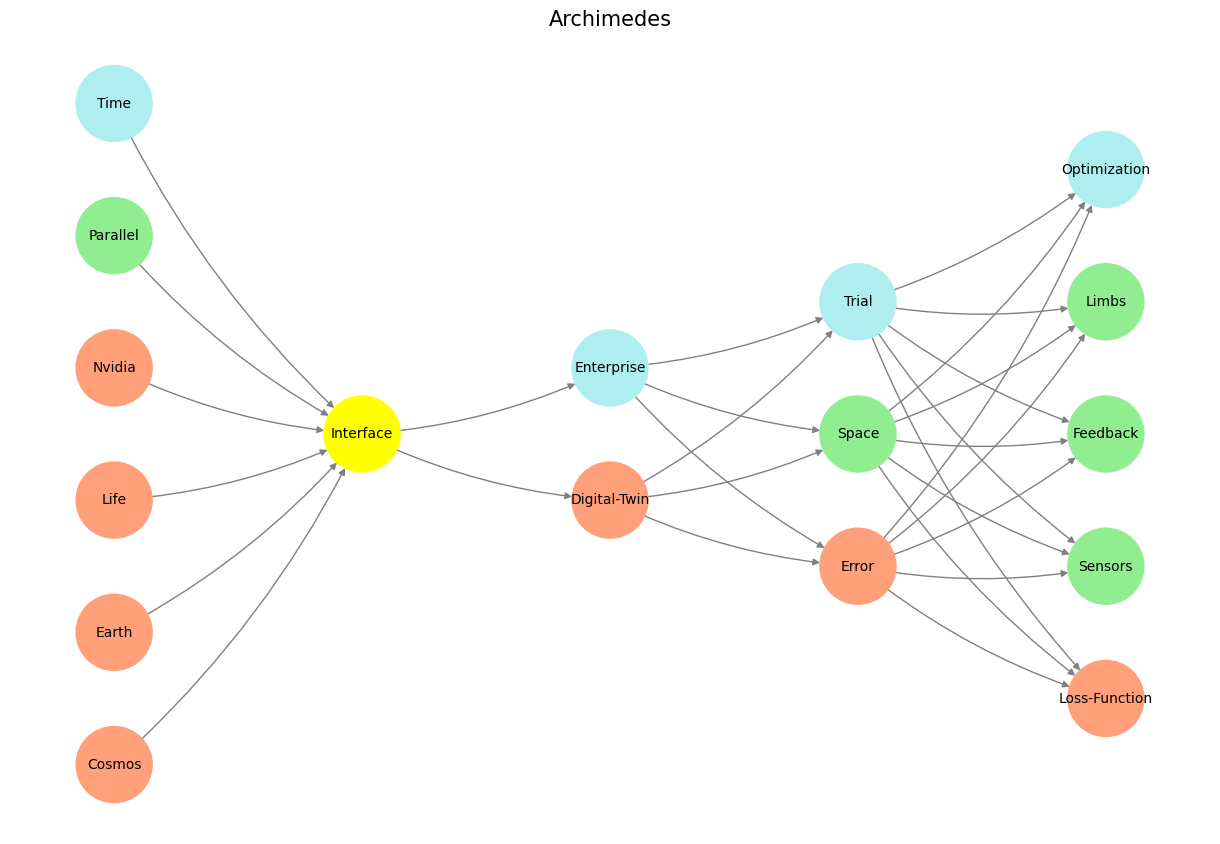Resource#
The neural network structure from World to Physicality elegantly mirrors the flow of artistic and interpretative processes in music, particularly when viewed through the lens of agency theory. The layers—World, Perception, Agency, Generativity, and Physicality—trace a natural progression from the universal to the individual, reflecting the transformation of raw inputs into realized performances. However, this structure also invites questions about the necessity of human involvement in certain roles, especially in the context of digitization and automation.
Are we trying to optimize the conductors affective state? Or instead should we minimize the error - difference between our tempo and a, perhaps, digitized metronome? Is efficiency the end-all-be-all?
The Role of Agency: Conductor or Metronome?#
The Agency layer, which includes nodes such as “Surprise & Resolution” and “Genre & Expectation,” encapsulates decision-making and interpretative nuance. This is where the human drama resides. Could a metronome, as a stand-in for a conductor, fulfill this role? Technically, yes, a metronome could enforce tempo with mechanical precision, eliminating disagreements like those between Gould and Bernstein. Yet, this reductionist approach overlooks the human capacity to interpret “surprise” and “resolution” dynamically.
In the 1962 Brahms First Piano Concerto performance, Bernstein and Gould embodied the clash of agency: the conductor’s role as arbiter of structural cohesion versus the soloist’s pursuit of personal expression. Their disagreement over tempo highlights why agency matters. A metronome would erase this conflict, but it would also strip the music of the generative tension that makes live performance compelling.
From Generativity to Physicality#
The transition from Generativity to Physicality—from the abstract crafting of melodies and rhythms to their tangible realization in performance—raises the question: Why preserve the “Maestro or Conductor” node in a world where solo performances or pre-programmed interpretations could suffice? The answer lies in the communal essence of music. The conductor serves as a bridge between individual agency and collective execution, guiding the ensemble to embody a shared vision. This role cannot be fully digitized without losing the adaptive interplay that occurs in real-time during performance.
The Network as a Model for Interpretation#
The neural network structure itself is an allegory for interpretative complexity. Each layer processes and transforms information, with earlier nodes (e.g., “Harmonic Series” in World) providing foundational inputs, while later nodes (e.g., “Theme & Variation” in Physicality) embody the culmination of this flow. The inclusion of nodes like “Maestro or Conductor” and “Call & Answer” acknowledges that music is not merely a sequence of notes but a dynamic interplay of intention and reception. Removing human roles from the process—whether conductor or performer—would disrupt the feedback loops that sustain this flow.
Why the Human Drama?#
The human drama exists because music, like the neural network, thrives on ambiguity and multiplicity. The conflict between Gould and Bernstein exemplifies the richness of interpretative divergence, inviting audiences to engage not only with the music but with the philosophical questions it raises: Should interpretation prioritize fidelity to the score, or should it privilege individual artistry? By preserving these tensions, music remains a living art form.
Digitization, while efficient, risks reducing music to a static artifact. The human elements—conflict, compromise, and creativity—are essential to maintaining music’s status as a generative process rather than a mere output. In this sense, the neural network serves as a metaphor for the delicate balance between structure and freedom, a balance that humans, not machines, are uniquely equipped to navigate.
In conclusion, replacing the conductor with a metronome might resolve conflicts like those between Gould and Bernstein, but it would do so at the cost of eliminating the very drama that makes music meaningful. The layers of the network remind us that music is more than a series of inputs and outputs; it is a dialogue—between performers, between the past and the present, and ultimately, between humanity and its artistic aspirations.
Show code cell source
import numpy as np
import matplotlib.pyplot as plt
import networkx as nx
# Define the neural network structure; modified to align with "Aprés Moi, Le Déluge" (i.e. Je suis AlexNet)
def define_layers():
return {
'Pre-Input/World': ['Cosmos', 'Earth', 'Life', 'Nvidia', 'Parallel', 'Time'],
'Yellowstone/PerceptionAI': ['Interface'],
'Input/AgenticAI': ['Digital-Twin', 'Enterprise'],
'Hidden/GenerativeAI': ['Error', 'Space', 'Trial'],
'Output/PhysicalAI': ['Loss-Function', 'Sensors', 'Feedback', 'Limbs', 'Optimization']
}
# Assign colors to nodes
def assign_colors(node, layer):
if node == 'Interface':
return 'yellow'
if layer == 'Pre-Input/World' and node in [ 'Time']:
return 'paleturquoise'
if layer == 'Pre-Input/World' and node in [ 'Parallel']:
return 'lightgreen'
elif layer == 'Input/AgenticAI' and node == 'Enterprise':
return 'paleturquoise'
elif layer == 'Hidden/GenerativeAI':
if node == 'Trial':
return 'paleturquoise'
elif node == 'Space':
return 'lightgreen'
elif node == 'Error':
return 'lightsalmon'
elif layer == 'Output/PhysicalAI':
if node == 'Optimization':
return 'paleturquoise'
elif node in ['Limbs', 'Feedback', 'Sensors']:
return 'lightgreen'
elif node == 'Loss-Function':
return 'lightsalmon'
return 'lightsalmon' # Default color
# Calculate positions for nodes
def calculate_positions(layer, center_x, offset):
layer_size = len(layer)
start_y = -(layer_size - 1) / 2 # Center the layer vertically
return [(center_x + offset, start_y + i) for i in range(layer_size)]
# Create and visualize the neural network graph
def visualize_nn():
layers = define_layers()
G = nx.DiGraph()
pos = {}
node_colors = []
center_x = 0 # Align nodes horizontally
# Add nodes and assign positions
for i, (layer_name, nodes) in enumerate(layers.items()):
y_positions = calculate_positions(nodes, center_x, offset=-len(layers) + i + 1)
for node, position in zip(nodes, y_positions):
G.add_node(node, layer=layer_name)
pos[node] = position
node_colors.append(assign_colors(node, layer_name))
# Add edges (without weights)
for layer_pair in [
('Pre-Input/World', 'Yellowstone/PerceptionAI'), ('Yellowstone/PerceptionAI', 'Input/AgenticAI'), ('Input/AgenticAI', 'Hidden/GenerativeAI'), ('Hidden/GenerativeAI', 'Output/PhysicalAI')
]:
source_layer, target_layer = layer_pair
for source in layers[source_layer]:
for target in layers[target_layer]:
G.add_edge(source, target)
# Draw the graph
plt.figure(figsize=(12, 8))
nx.draw(
G, pos, with_labels=True, node_color=node_colors, edge_color='gray',
node_size=3000, font_size=10, connectionstyle="arc3,rad=0.1"
)
plt.title("Archimedes", fontsize=15)
plt.show()
# Run the visualization
visualize_nn()


Fig. 20 In the 2006 movie Apocalypto, a solar eclipse occurs while Jaguar Paw is on the altar. The Maya interpret the eclipse as a sign that the gods are content and will spare the remaining captives. Source: Search Labs | AI Overview#

